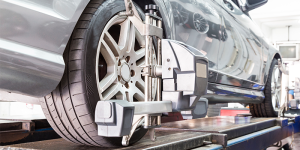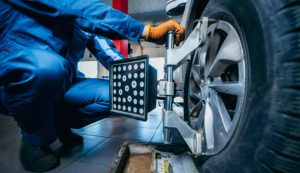Proper suspension alignment is essential for safe driving, optimal tire performance, and vehicle stability. Whether you’re noticing uneven tire wear or your vehicle is pulling to one side, the root of the issue may lie in your alignment angles — specifically camber, toe, and caster.
These three alignment angles work together to ensure that your wheels are correctly positioned relative to the road and your vehicle’s frame. Understanding what they are, how they affect performance, and when to adjust them can save you money and prevent future suspension issues.
What Are Suspension Alignment Angles?

Suspension alignment refers to adjusting the angles of your vehicle’s wheels so they make proper contact with the road surface. The key angles in any alignment check are:
-
Camber
-
Toe
-
Caster
These angles are measured in degrees and fractions of degrees, and even slight misalignments can significantly affect your vehicle’s handling, tire wear, and fuel economy.
Angle #1: Camber
Camber is the inward or outward tilt of the wheel when viewed from the front of the vehicle.
| Type of Camber | Description | Effect on Vehicle |
|---|---|---|
| Negative | Top of the tire tilts inward | Better cornering grip, uneven wear |
| Positive | Top of the tire tilts outward | Reduced grip, increased tire wear |
| Zero | Tire sits flat on the road | Even tire wear, stable straight-line |
Proper Camber Benefits:
-
Optimized tire contact in turns
-
Enhanced grip for high-performance driving
-
Even wear with proper setup
Incorrect Camber Issues:
-
Uneven tire wear (inside or outside edge)
-
Pulling to one side
-
Reduced tire life
Angle #2: Toe
Toe refers to the angle at which the tires point inward or outward when viewed from above.
| Type of Toe | Description | Effect on Vehicle |
|---|---|---|
| Toe-In | Front of tires point toward each other | Stability in straight lines |
| Toe-Out | Front of tires point away from each other | Quicker steering response, less stability |
| Zero Toe | Tires are perfectly parallel | Neutral handling, minimal tire wear |
Proper Toe Benefits:
-
Straight tracking at high speeds
-
Reduced tire drag
-
Even tire wear
Incorrect Toe Issues:
-
Rapid feathered tire wear
-
Poor steering response
-
Vehicle veers during driving
Angle #3: Caster
Caster is the angle of the steering axis when viewed from the side of the vehicle. It affects how your steering wheel returns to center and overall stability.
| Type of Caster | Description | Effect on Vehicle |
|---|---|---|
| Positive | Steering axis tilts toward driver at the top | Improved straight-line stability |
| Negative | Steering axis tilts away from driver | Poor return-to-center, wandering feel |
| Zero | No tilt | Reduced handling precision |
Proper Caster Benefits:
-
Steering wheel self-centers after turns
-
Better cornering stability
-
Enhanced high-speed control
Incorrect Caster Issues:
-
Drifting or wandering
-
Steering fatigue on long drives
-
Misaligned steering wheel position
Summary Table: Alignment Angles Overview
| Alignment Angle | Affects | Correct Setting Goal | Misalignment Effect |
|---|---|---|---|
| Camber | Tire contact & cornering | Slightly negative for performance | Uneven tire wear, pulling |
| Toe | Tire wear & tracking | Close to zero or slight toe-in | Feathering, drifting, instability |
| Caster | Steering feel & stability | Positive angle | Poor return to center, unstable steering |
Why Suspension Alignment Matters
Proper alignment improves not only tire life but also ride comfort, steering precision, and fuel efficiency. Misaligned suspension components can lead to:
-
Accelerated tire wear
-
Poor fuel economy
-
Loose or erratic steering
-
Increased stress on suspension parts
Signs You Need a Wheel Alignment
-
Uneven or rapid tire wear
-
Vehicle pulls left or right
-
Steering wheel isn’t centered
-
Loose or wandering steering
-
Squealing tires while turning
How Alignment is Performed
Professional wheel alignment is done using laser or computer-guided systems that measure each angle with extreme precision. The technician adjusts:
-
Tie rods to correct toe
-
Upper/lower control arms or cam bolts to adjust camber
-
Strut mount position or caster adjustment bolts for caster
DIY Tips for Alignment Awareness

While wheel alignment should be handled by professionals, you can monitor alignment health at home by:
-
Regularly inspecting tire tread patterns
-
Checking tire pressure weekly
-
Noticing changes in steering or vehicle pull
-
Scheduling alignment checks every 10,000–15,000 km or after hitting large potholes
Suspension Components Affected by Misalignment
Poor alignment doesn’t just damage tires — it stresses suspension parts including:
-
Control arms
-
Ball joints
-
Tie rods
-
Bushings
-
Struts and shocks
Neglecting alignment can result in premature wear of these parts, leading to more costly repairs.
Need to replace worn components? Check this link:
Buy Suspension online — Get high-quality parts like control arms, tie rods, bushings, and more tailored to your vehicle.
Alignment Recommendations by Vehicle Type
| Vehicle Type | Camber | Toe | Caster |
|---|---|---|---|
| Daily Driver | Neutral | Slight toe-in | Positive |
| Sports Car | -1 to -2° | Zero or toe-out | +3 to +5° |
| Off-Road Vehicle | Neutral | Slight toe-in | Positive |
| Heavy-Duty Truck | Slightly negative | Toe-in | Positive |
Final Thoughts
Understanding camber, toe, and caster can help you maintain a smooth, stable, and efficient ride. These alignment angles aren’t just for high-performance cars—they’re critical to everyday driving and long-term vehicle health.
Regular alignment checks, especially after suspension work or encountering rough roads, can extend tire life and improve safety.
Don’t let misalignment cost you comfort or control.
Buy Suspension online — Get the suspension parts you need to keep your vehicle aligned, stable, and road-ready.